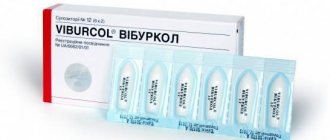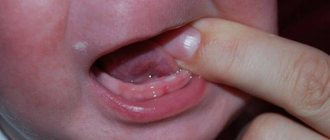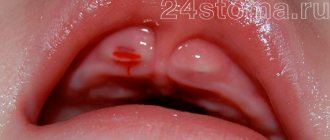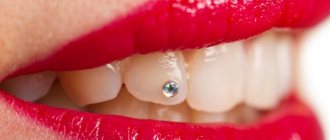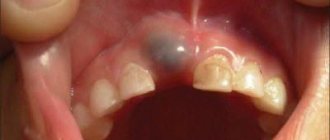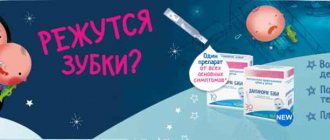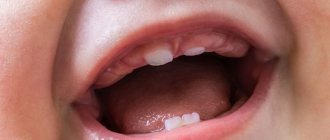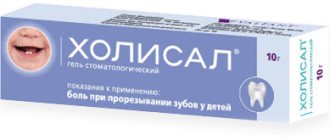Teething is an obligatory process in the life of every child. This period can be completely painless, but in many cases, teething is accompanied by pain and causes discomfort for the child and anxiety for the parents.
Baby teeth emerge from the gum surface at about 6 months of age. During this period, the child may become capricious, eat poorly, and sleep poorly.
Teething is indicated by swollen gums and the production of large amounts of saliva. In more severe cases, a runny nose, cough, diarrhea and vomiting may occur. An increase in temperature to 38⁰ is often observed.
Every mother strives to make the teething process easier for her child. If nothing bothers the baby, then the mother shouldn’t worry, she just needs to watch.
The use of various remedies is necessary only in cases where the child is really unwell - the pain prevents him from eating or sleeping, and the high temperature persists for a long time.
To alleviate the condition of children during teething, rectal suppositories are used, the most popular of which, undoubtedly, are Viburkol suppositories.
Before you start using any remedy, you need to make sure that the child’s painful condition is associated specifically with teething. To do this, you need to visit a pediatrician.
When and in what order do baby teeth emerge?
For most children, the teething pattern looks like this:
- At 6-8 months, two central lower incisors appear.
- At 8-9 months, the upper central incisors.
- At 9-12 months, the upper lateral incisors erupt.
- At 11-12 months, the lower lateral incisors.
- At 12-15 months, the upper and lower molars.
- At 16-18 months, the upper canines
- At 18-20 months, the lower canines.
- Chewing teeth erupt at 2-3 years of age.
During normal development, baby teeth erupt in each area within 2-10 days, and the most unpleasant symptoms usually appear within 2-5 days. All 20 baby teeth erupt by age 3.
What to do if teeth are cut chaotically and behind schedule?
There is no need to sound the alarm right away. In some children, teething begins at 3 months, and in some at 10, and this is not a pathology, but a feature of the body. The same applies to the violation of the order of appearance of the incisors.
But if there is a delay of 3-5 months, you need to go for a consultation with a pediatrician or dentist.
Viferon gel: instructions, price
Viferon gel is used (as well as suppositories) for the treatment of acute and recurrent herpetic stomatitis. The gel is applied 4-5 times a day directly to the lesions on the oral mucosa (24stoma.ru). Before applying the gel, it is advisable to dry the mucous membrane with a dry gauze swab, then apply the gel to the lesions using a spatula or a cotton swab. The course of treatment is from 5 to 10 days (until symptoms disappear).
Viferon gel is also suitable for treating not only the mucous membrane, but also the red border of the lips. The drug can be used by pregnant and lactating women without any restrictions (due to the low absorption of the active ingredients through the mucous membrane). Viferon gel – the price will be 0t 150 rubles.
What are the common teething symptoms and what do you recommend?
- Profuse salivation.
One of the most obvious signs is when drool is literally flowing in a stream. Moreover, the symptom may appear a couple of months before the start of eruption.
Saliva should be carefully wiped away as it appears damp towel or napkin so as not to damage the skin. It is best to use wipes that contain xylitol - it prevents the growth of bacteria and the appearance of rashes on the skin.
- A strong desire to put everything in the mouth and chew.
Chewing helps your baby relieve the itching. The main thing is to hide objects that he could accidentally swallow or injure himself.
Lifehack. Bend your index finger and gently insert it into your baby's mouth. If he starts squeezing it with his gums, it means teeth are definitely coming out. If it just sucks, then it’s something else.
- Skin rashes.
A small rash on the cheeks or chin may occur due to skin contact with saliva. On irritated skin you just need to apply baby moisturizer.
ATTENTION! If the rash around the mouth appears without other symptoms of teething, it is better to show the child to the pediatrician!
- The baby cannot suckle normally.
At the peak of feeding, he abandons her and begins to act up. And sometimes he can bite with his gums. In such a situation, there is no need to force the child to eat. Even if he misses 2-3 feedings, nothing bad will happen. When he gets really hungry, he will still take the breast or bottle and eat. If you have no appetite for more than 24 hours, call a doctor.
- Redness and swelling of the gums.
It begins 2-5 days before teeth appear, goes away on its own, you don’t need to do anything.
You can also notice a blue bubble on the gum. This is a eruption hematoma. It occurs as a result of the destruction of small vessels in the gums during tooth eruption. It does not require any specific treatment. It will soon resolve on its own.
When can the medicine be used?
The drug is indicated for the treatment of respiratory infections of viral etiology. The medicine effectively relieves symptoms of influenza, respiratory syncytial, rhinovirus and other infections. It is actively used to treat COVID-19, including in children, pregnant and lactating women. The medication can be used even with the addition of bacterial flora:
- Inflammation of the membranes and tissue of the brain;
- Infection in the womb (cytomegalovirus, herpes, candidiasis, chlamydia, etc.);
- Pneumonia;
- Pathologies of the reproductive organs (trichomoniasis, ureaplasmosis, HPV and others).
Viferon can be prescribed together with antibacterial and antifungal medications, as it increases the immune defense of the entire body.
The product is effective against viral intestinal diseases, namely: rotavirus, enterovirus. When using the drug, vomiting, nausea, abdominal pain, diarrhea, and intoxication quickly go away.
The medicine is often used for herpetic rashes caused by Herpes simplex types 1 and 2. The product relieves itching and rash.
The drug can be used even in newborns and premature infants. It does not cause serious complications and is non-toxic.
What are the complications, and when to see a doctor?
| Symptom | Teeth are being cut, there is no need to go to the pediatrician | The disease develops, contact your pediatrician |
| Cough | A coughing attack begins due to excess salivation. The cough is wet and infrequent. | The cough gets worse, does not go away, does not allow the baby to sleep, and prevents him from eating. Doesn't stop for more than 2 days. Breathe heavily. |
| Nasal discharge | Nasal discharge is transparent and watery and disappears by the 4th day. | The runny nose does not go away for the 4th day. Lots of yellow or green discharge. |
| Heat | The temperature does not exceed 38 °C and lasts no more than 2-3 days. Rapidly decreases under the influence of antipyretics. | Fever above 38.5 °C for more than 2 days. Signs of a cold appear (severe cough and runny nose). |
| Loose stools | Lasts less than 72 hours. | Lasts more than 72 hours. |
| Changes in the oral cavity | The gums become swollen and red. | The oral mucosa is covered with white plaque or ulcers. |
The use of Viferon in dentistry -
In dentistry, this drug is used primarily for the treatment of herpetic stomatitis, which is caused by the herpes virus. It should be noted that stomatitis is not only of viral origin (herpes virus), but very often of allergic or bacterial origin.
The use of the drug makes sense only if the stomatitis is herpetic (i.e., viral in origin). The use of Viferon for other forms of stomatitis, for example, for aphthous stomatitis, is completely pointless, leads to delays in receiving proper treatment and, as a result, to a deterioration in well-being. Therefore, before starting treatment, it is necessary to determine the form of stomatitis.
→ Symptoms of the herpetic form of stomatitis → Symptoms of the aphthous form of stomatitis
Viferon suppositories for children: instructions for use
This form of the drug is administered rectally. There are no contraindications based on age, i.e. It can also be used by adults. For the treatment of acute and chronic recurrent herpetic stomatitis, the following course of treatment is used: 1 suppository (see dosage below) - 2 times a day. The interval between use should be 12 hours. The course of treatment is 10-12 days.
- for newborns and children under 7 years old – 150,000 IU 2 times a day,
- for children over 7 years old – 500,000 IU 2 times a day,
- for the treatment of adults - from 1,000,000 IU 2 times a day.
Viferon suppositories for children: reviews of suppositories are the best form of the drug for young children, while attempts to use forms for topical use (especially when it is necessary to treat the oral mucosa) are perceived negatively by children, they begin to cry, treatment with gel causes the child to increased salivation and drooling from the mouth.
Viferon candles: price (package No. 10)
- candles of 150,000 IU - about 300 rubles,
- candles 500,000 IU - from 400 rubles,
- candles 1,000,000 IU - from 550 rubles,
- candles for 3,000,000 IU - from 900 rubles.
Use in pregnant and lactating women - Viferon suppositories can be used during pregnancy and breastfeeding without restrictions, but only starting from the 14th week of pregnancy.
What can be done to help a child with severe itching and pain?
- Carry your baby in your arms more often, play with him and distract him.
- Give chilled water in a bottle, cool fruit puree or kefir. The main thing is that the liquid is not too cold, otherwise the baby will catch a cold.
- Massage the gums with a special silicone brush (see picture above) or you can gently use your clean finger.
- Buy your baby a teether and let's chew.
Such devices are made from plastic, rubber, silicone, wood, or a combination of different materials. The surface of the toys should be elastic and uneven to make it easier for the child to scratch the gums. A cooled teether relieves itching better, so it can be placed in the refrigerator to cool for 10-15 minutes. But don't chill it in the freezer!
- Do not use gum gels with lidocaine and benzocaine.
The child has a lot of saliva in the mouth, so gels are not effective during this period. The child swallows most of the gel.
Pros and cons of suppositories
Rectal suppositories have the following advantages:
- complete absorption - it is difficult for a small child to administer the medicine orally, therefore most of it may simply not enter the body;
- fast action - suppositories are absorbed by the intestinal walls and enter the bloodstream faster, as a result of which the effect occurs within a short time;
- minimal load on the gastrointestinal tract and liver.
There are also disadvantages:
- discomfort when inserting a suppository;
- the possibility of injury to the skin of the anus if inserted incorrectly;
- irritation of the rectal mucosa.
What should you not do when your baby is teething?
- Strongly touch the child’s gums with your fingers, press on them and pick them out. This can increase pain or cause infection.
- Conduct vaccination, because immune system is weakened during this period .
- Without supervision, allow your child to chew any hard foods that could cause choking.
- Give homeopathic remedies. Not only will they not help the child, but they can cause serious harm.
The eruption of baby teeth is not a problem, but a natural process for a child’s body. But if you are not sure about something, do not hesitate to ask specialists. If you have any questions, write to us on Instagram.
The drug Viferon: reviews and studies
Let us say right away that the treatment of viral and bacterial diseases with interferons is recognized in the USA and Europe, and even in Kazakhstan, which is close to us, as ineffective. Clinical studies that were published in Russia have a level of evidence – class II (B). This means that small randomized controlled clinical trials were conducted, involving only a small number of people. From the point of view of evidence-based medicine, such studies do not inspire much confidence. Nevertheless, sales of Viferon are a very large market of several billion rubles.
As a doctor (my personal opinion), I do not consider the drug Viferon to be effective, and I have never seen a significant positive result from its mono use. As for patients, patient reviews of Viferon are absolutely diverse, because... Patients usually take several medications at once. Therefore, it is easy to make a mistake in interpreting the results, because the result could have been achieved through another drug, or simply through the natural cessation of the disease. This is well demonstrated by the proverb: To treat a cold or not to treat it, it will still go away in 7 days.
special instructions
The drug should not be used for generalized or atypical herpetic infections. Since the medicine can cause an allergic reaction, it is not prescribed for atopic dermatitis or eczematous rashes. The drug is not recommended for:
- tumor processes on the skin,
- familial pemphigus Gougereau-Hailey,
- mental disorders,
- simultaneous use of sedative drugs,
- neutropenia less than 1.5×109,
- the platelet count in the blood is less than 90,000/µl,
- diseases in which there is a disruption of the central nervous system.
Instructions for use
The medicine in suppositories is used rectally (the suppository is inserted into the anus). To insert suppositories correctly, you need to spread your buttocks and insert a suppository into the anus. After administering the medicine, you should lie down for half an hour. During this time the candle will dissolve.
Now we will tell you how to place a Viferon suppository rectally for a baby. For children, suppositories are administered in a position on their side (newborns) or on their stomach (children over 1 year). To administer the medication, spread the buttocks and insert a suppository into the anus. Next, squeeze the gluteal muscles and hold the child in this position for 2-3 minutes (since the candle may slip out). After administering the drug, the baby should lie down for half an hour.
